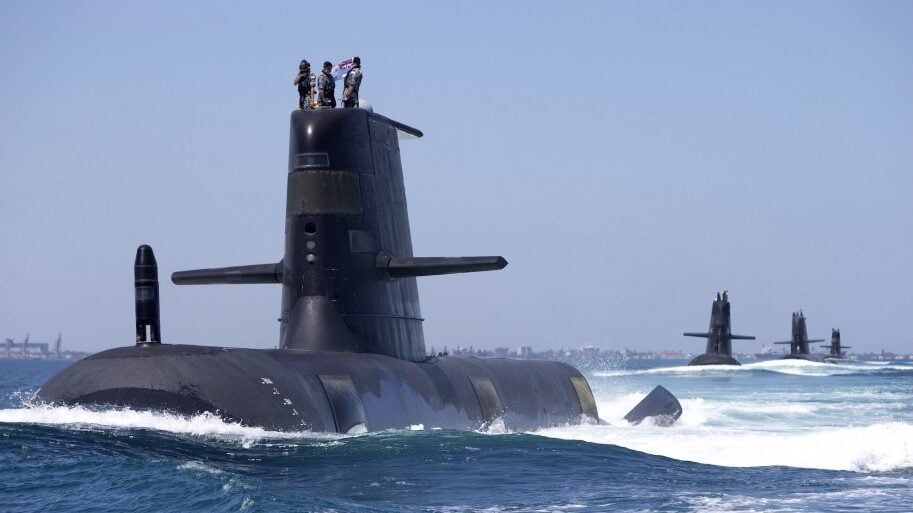
Australian Collins class subs HMAS Collins, HMAS Farncomb, HMAS Dechaineux and HMAS Sheean transiting Cockburn Sound, Western Australia. (Royal Australian Navy)
SYDNEY — Australia is likely to get at least three Virginia-class nuclear attack submarines to bridge the looming capability gap between its Collins-class submarine retirements and the arrival of the first Australian-built boats, under the defense technology agreement known as AUKUS.
That looks to be the most immediate decision by the United States, United Kingdom and Australia, along with the Lucky Country committing to building and deploying a fleet of attack boats.
Leaks about the AUKUS submarine decision, published by a half dozen international wires and major newspapers, poured across the dam of secrecy in the last 24 hours. The formal announcement of the plan by the American president and the prime ministers of Australia and Britain is expected Monday in San Diego, perhaps with the symbolic backdrop of the Pacific Ocean and a nuclear-powered submarine. Breaking Defense was first to report the location of the meeting.
Per the reporting, Australia is poised to buy an initial three Virginia-class subs, with the option to add two more if necessary. That will bridge a gap as Australia builds up its nuclear and shipyard workforces, design and build highly secure shipyards where the boats can be built and maintained with limited chances of espionage occurring, and train its submariners in how to manage one of the most strategic weapons on earth.
Virginia-class subs will probably require an additional production line to ease the already considerable strains on America’s sub shipyards, said Malcolm Davis, an expert at the Australian Strategic Policy Institute. Both the US Congress and the Navy are deeply concerned that efforts to bolster Australia’s sub fleet do not cut into America’s ability to build enough attack subs to meet its own requirements. As a result, Australia may have to bear much of the cost of building and running a new production line.
Down the line, reports indicate, the Royal Australian Navy will then build and deploy its own unique subs, derived from Britain’s Submersible Ship Nuclear Replacement (SSNR), successor to the Royal Navy’s Astute-class. The Australian subs will likely use Lockheed Martin’s combat system, so they are compatible with the Collins-class and the American sub fleet.
RELATED: Growing signs Australia’s new nuclear sub will be British design
This means, notes Davis, that Australia will operate at least two classes of nuclear boats, which will certainly complicate sustainment and logistics at a time when the country’s military will be learning how to design, build, operate, fight and maintain a new class of weapon.
Why is Australia taking on the risk of, essentially, developing two production and support lines?
“I think the capability gap really has them spooked, so that’s why they’re doing this,” Davis says. US Defense Secretary Lloyd Austin pledged in early December that the US “will not allow” a capability gap to appear between Australia’s Collins-class sub retirement, planned for 2039, and the deployment of its first nuke powered attack subs.
What will happen to the conventionally-powered Collins boats as the US boats come on stream? “From six, they might slowly taper down until most of the Collins may be basically tied up at the dock,” says Davis.
What do Australian experts make of what they’ve heard so far? Davis says his country faces “huge political risk in this, and huge costs. It’s going to be an extremely bumpy ride.”
Initial reaction from influential defense voices here were not positive. Ben Packham, defense reporter at Australia’s arguably most influential paper, The Australian, posted a tweet saying the possible purchase of two different classes of nuclear boats “sounds completely nuts.”
If this is the ‘optimal pathway’ to get nuclear subs it sounds completely nuts. Why would we, having done the hard yards to get Virginia-class boats, then embark on yet another nuclear sub program with all of its own diabolically difficult issues? https://t.co/fra2opNhCZ
— Ben Packham (@bennpackham) March 9, 2023
Kym Bergmann, editor of the Australian Pacific Defense Reporter, published an editorial castigating his country: “Let’s hope that the rumours [about two nuclear sub classes] are incorrect because otherwise this is looking like a thoroughly bad deal for Australia. As well as costing a vast amount of money – tens of billions of dollars – the effect on national security for the next 30 years will be minimal.”
For his part, Davis of ASPI wonders if it might make more sense to put the brakes on the sub deals and wait for the American B-21 bomber to be available for Australian purchase: “Would we be better off in investing on B-21s in terms of impactful projection?” That awkward term has been used by Defense Minister Richard Marles and appears to refer to the burgeoning ability of Australia to engage in long-range strike and power projection.
However, political realities also play a part. Building a nuclear sub in Australia, the best known goal of the AUKUS agreement, will provide thousands of jobs in Adelaide. As Davis notes, losing those jobs in a key state for Albanese’s party, “would be a huge blow for labor.”
More Breaking Defense Coverage of AUKUS:
- Eye on AUKUS, Aussie defense minister pushes US on ITAR – gently
- Ahead of AUKUS big reveal, British ambassador knocks Aussie ex-defense minister over sub talk
- Australian Greens press Labor over nuclear weapons, as AUKUS decision looms
- Australian opposition head says no British subs for AUKUS, draws rebuke
- EXCLUSIVE: Reed, Inhofe warn Biden AUKUS risks becoming ‘zero sum game’ for US Navy






















